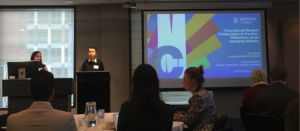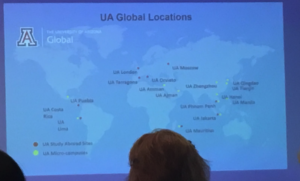Global education market insights: the outlook from APAC
International Education Association of Australia’s Transnational Education Forum August 2019 – a summary by Fiona Reay, Development Partnership Lead at FutureLearn
FutureLearn attended the IEAA Transnational Education Forum held at Victoria University to better understand successful education partnerships across borders, particularly in Asia Pacific. Read on to learn about the Indonesian market (the next booming population of students), case studies from RMIT, Monash and Arizona University’s about their learnings from dual university degrees in Asia; and the direction and opportunities for the future of Australian TNE strategy from Austrade, TAFE, and Navitas.
1. Big promises for Indonesian education market
2. South East Asia case studies from Monash, RMIT and Arizona
3. Shaping Australia’s future Transnational Education strategy
1. Big promises for Indonesian education market
Why Indonesia and why now?
Indonesia currently holds the 16th largest economy globally, and with 5% year-on-year growth it is projected to be the fifth largest economy by 2030. With a young population of digital natives and a lack of strong secondary education, and despite recent political engagement on fixing this historic via an ambitious new skills development agenda, the scale of the need completely outweighs their current supply capacity. In 2018, Indonesia had 8 million higher education students across 4,000 institutions, and every year the sector grows to accommodate 500,000 more. The Indonesia Online Education Roadmap is due for release in October, and is being overseen by the Indonesia Cyber Institute.
Digital economy and tech education demands
Indonesia is strongly tipped to have the largest digital economy in South East Asia within the next 5 years, with thousands of co-working spaces popping up, and $5 billion in startup valuations in the past 3 years, including four unicorns ($1b companies) out of 11 in SE Asia, such as the local Uber transport marketplace GoJEK. Indonesia are investing heavily in “training the trainers” in emerging technology fields such as artificial intelligence and augmented reality. So far, the corporate sector has been doing the training of young digital natives rather than the education sector, examples of this include bukalapak.com partnering with universities to build AI centres and Apple starting their own app development academy in Jakarta.
Australian experience to date as #1 outbound destination for Indonesians
The most popular model so far is a “double-degree” i.e. Bachelor of Business plus another Bachelor as a joint degree with a local Indonesian university. The benefit is the local partner facilitates all the regulatory approvals and Indonesia now allows for the world’s top 200 universities to open a local campus – as long as they provide two programmes within a STEM field. Many financial incentives are now in place, and the recent free trade agreement between Australia and Indonesia IA-CEPA guarantees conditions for Australian education providers. Austrade have published their Indonesia Market Action Plan 2019 supporting student recruitment – which features a strong digital and cyber focus.
2. South East Asia case studies
Virtual transnational education between Kuala Lumpur and Melbourne

Monash University’s SE Asia Senior Pro Vice-Chancellor, Professor Andrew MacIntrye, noted their ongoing desire to embed themselves outside Australia, and highlighted that they are already a big player in Malaysia, where they have invested for the longer term. Indonesia is a big feeder into their Malaysian campus, so their next proposed move is to consider a post-graduate campus in Indonesia.
Monash College provides foundation year studies (a feeder year for international students) to get into the first year of university in Australia – it’s pitched as a global programme and the key to its delivery has been the intercultural competence development of their teachers. Rachel Chamberlain and Mia Olerhed outlined how they have helped equip their teachers to talk about sensitive topics students from Malaysia and China are keen to discuss such as religion and LGBTQ+.
Royal Melbourne Institute of Technology (RMIT)’s student experience around ‘global citizenship’

Sam Baille, Associate Director of Global Entities and Experiences, detailed a renewed focus on creating intercultural conversations for their on-campus students which featured their “three Os” for global experience – overseas, on campus and online. One in ten RMIT students had a global experience, and while they rank fourth in Australia for student exchanges and transnational education (16,000 of an 80,000 total student population), many of their students are already working full time, have mortgages and children.
RMIT have partnered in Melbourne, Singapore and Vietnam with an organisation called Common Purpose, who provide local outreach to industry and help to run challenges such as Hackathons for thinking about leadership across borders. They have also partnered with City University in London to broaden the diversity of people doing the programme, and even transport students from their nine global campuses (funding 925 international trips) in order to to bring them all together under one roof – a pioneering feat.
Dual degrees: creating the Arizona American University of Phnom Penn

Global Director for SE Asia at Arizona University, Hillary Vance, explained their global ambitions for transferable credit between partner universities (students receive certificates from each university on completion).
Arizona use their networks to access new territories and meet their partners where they are. They have a goal of 25 micro-campuses by 2020 – primarily in business and STEM programmes.
Arizona and their partners prefer to take a flipped classroom approach when setting up new campuses, and focus on the digital connections between countries by ensuring the physical spaces are flexible with facilities such as portable chairs, walls, projectors, and more.
3. Shaping Australia’s future Transnational Education strategy
Leaders from Austrade, TEQSA, Navitas and the vocational education sector differentiated Australia’s education value proposition as being founded in quality, highlighting the extensive quality assurance frameworks in place. “International skills” are being talked about regularly by presidents in China, Indonesia and more and the sector needs to work together to provide a more integrated approach.
Underexplored opportunities to date
Skills training:
- International skills training programmes can be adapted by taking the Austalian government’s ‘train the trainer’ model and delivering microcredentials offshore. “Skillsets” and “units of competency” are already used in the VET sector, therefore are well known in Australia, and ripely positioned to service the 70% of Chinese nationals who require skills-based training.
Online markets:
- The US has 40,000 online students – including one university with 5,000 and seven others enrolling over a thousand each – while the UK has nine universities enrolling over 2,000 students so far.
International schools:
-
- There are currently 6 million students in “international school” education systems. The rise in middle class parents (particularly in Asia) may be a lost opportunity for Australia as they do not have a national secondary certificate.




